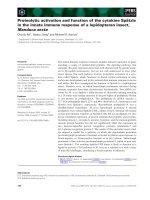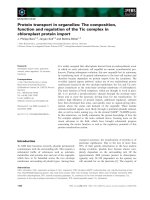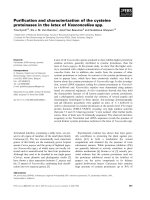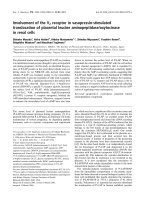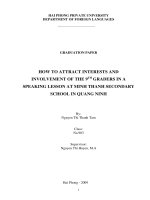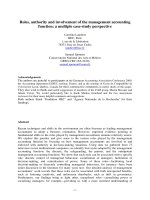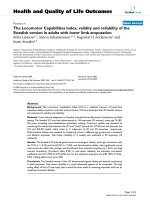How to attract interests and involvement of the 9th graders in a speaking lessons at Minh Thanh secondary in Quang Ninh
Bạn đang xem bản rút gọn của tài liệu. Xem và tải ngay bản đầy đủ của tài liệu tại đây (4.81 MB, 119 trang )
HAI PHONG PRIVATE UNIVERSITY
DEPARTMENT OF FOREIGN LANGUAGES
-------------------------------------
GRADUATION PAPER
HOW TO ATTRACT INTERESTS AND
INVOLVEMENT OF THE 9TH GRADERS IN A
SPEAKING LESSON AT MINH THANH SECONDARY
SCHOOL IN QUANG NINH
By:
Nguyen Thi Thanh Tam
Class:
Na 903
Supervisor:
Nguyen Thi Huyen, M.A
Hai Phong - 2009
1
BỘ GIÁO DỤC VÀ ĐÀO TẠO
TRƯỜNG ĐẠI HỌC DÂN LẬP HẢI PHÒNG
---------------------------------------
NHIỆM VỤ ĐỀ TÀI TỐT NGHIỆP
Sinh viên: …………………
Mã số: ……………………….
Lớp: …………………………………..
Ngành: ……………………….
Tên đề tài: ………………………………………………………………….
………………………………………………………………………………
………………………………………………………………………………
……………………………………………………………………..
2
NHIỆM VỤ ĐỀ TÀI
1. Nội dung và các yêu cầu cần giải quyết trong nhiệm vụ đề tài tốt nghiệp
(Về lí luận, thực tiễn, các số liệu cần tính tốn và các bản vẽ)
……………………………………………………………………………
…………………………………………………………………………………
…………………………………………………………………………………
…………………………………………………………………………………
…………………………………………………………………………………
……………………………………………………….
2. Các số liệu cần thiết để thiết kế, tính tốn
…………………………………………………………………………….
…………………………………………………………………………….
……………………………………………………………………………..
……………………………………………………………………………..
……………………………………………………………………………..
……………………………………………………………………………..
3. Địa điểm thực tập
…………………………………………………………………………….
…………………………………………………………………………….
……………………………………………………………………………..
……………………………………………………………………………..
……………………………………………………………………………..
……………………………………………………………………………..
3
CÁN BỘ HƯỚNG DẪN ĐỀ TÀI TỐT NGHIỆP
Người hướng dẫn thứ nhất:
Họ và tên: ...............................................................................................................
Học hàm, học vị: ....................................................................................................
Cơ quan công tác: ...................................................................................................
Nội dung hướng dẫn: ..............................................................................................
.................................................................................................................................
Người hướng dẫn thứ hai:
Họ và tên: ................................................................................................................
Học hàm, học vị: ....................................................................................................
Cơ quan công tác: ....................................................................................................
Nội dung hướng dẫn: ...............................................................................................
.................................................................................................................................
.................................................................................................................................
Đề tài tốt nghiệp được giao ngày….. tháng ….. năm ….. 2009
Yêu cầu hoàn thành trước ngày…..tháng….. năm….. 2009
Đã nhận nhiệm vụ Đ.T.T.N
Đã giao nhiệm vụ Đ.T.T.N
Cán bộ hướng dẫn Đ.T.T.N
Sinh viên
Hải Phòng, ngày…. tháng…..năm 2009
Hiu trng
GS.TS. Trần Hữu Nghị
4
PHẦN NHẬN XÉT TÓM TẮT CỦA CÁN BỘ HƯỚNG DẪN
1. Tinh thần thái độ của sinh viên trong quả trình làm đề tài tốt nghiệp:
……………………………………………………………………………
……………………………………………………………………………
……………………………………………………………………………
……………………………………………………………………………
……………………………………………………………………………
2. Đánh giá chất lượng của Đ.T.T.N (So với nội dung yêu cầu đã đề ra trong
nhiệm vụ Đ.T.N trên các mặt lí luận, thực tiễn, tính tốn giá trị sử dụng, chất
lượng các bản vẽ)
……………………………………………………………………………
……………………………………………………………………………
……………………………………………………………………………
……………………………………………………………………………
……………………………………………………………………………
3. Cho điểm của cán bộ hướng dẫn:
(Điểm ghi bằng số và chữ )
……………………………………………………………………………
……………………………………………………………………………
……………………………………………………………………………
……………………………………………………………………………
……………………………………………………………………………
…………………………………………………………………………
Hải Phòng, ngày….. tháng….. năm 2009
Ng ười hướng dẫn chính
(Họ tên và chữ ký)
5
NHẬN XÉT VÀ ĐÁNH GIÁ CỦA CÁN BỘ CHẤM PHẢN BIỆN ĐỀ TÀI
TỐT NGHIỆP
1. Đánh giá chất lượng đề tài tốt nghiệp về các mặt thu nhập và phân tích
số liệu ban đầu, cơ sở lí luận chọn phương án tối ưu, cách tính tốn
chất lượng thuyết minh và bản vẽ, giá trị lí luận và thực tiễn đề tài.
2. Cho điểm của cán bộ phản biện
(Điểm ghi bằng số v ch)
Hải Phòng ngythỏng nm 2009
Ngi chm phn bin
6
TABLE OF CONTENT
ACKNOWLEDGEMENT
TABLE OF CONTENTS
PART I: INTRODUCTION ............................................................................ 2
1. Rationale......................................................................................................... 2
2. Aims of the study ........................................................................................... 2
3. Scope of the study .......................................................................................... 3
4. Method of the study........................................................................................ 4
5. Design of the study ......................................................................................... 4
PART II: DEVELOPMENT ........................................................................... 6
Chapter 1: LITERATURE REVIEW ............................................................ 6
I. Speaking skill: an over view ........................................................................ 6
1. What is speaking?........................................................................................... 6
2. Types of speaking........................................................................................... 7
3. Types of speaking activities ........................................................................... 8
4. Characteristics of a successful speaking activity ........................................... 8
II. Teaching speaking ..................................................................................... 10
1. The importance of speaking skill ........................................................... 10
2. Why do students fell less interested and contribute less in a speaking
lesson? .................................................................................................... 10
3. Principles to attract students‟ involvements in English speaking lessons 11
4. Activities to promote students‟ speaking ................................................ 14
4.1 Why teacher should give students a variety of speaking activities ...... 14
4.2 Simple tips for teachers to have a successful speaking activity ........... 14
4.3 Activities to promote speaking ............................................................ 15
4.3.1 Information gap activities .................................................................. 15
4.3.2 Dialogues and role plays .................................................................... 15
4.3.4 Activities using pictures ..................................................................... 16
4.3.4 Problem-solving ................................................................................. 17
7
4.3.5 Using games ....................................................................................... 17
Chapter 2: study on how a speaking lesson is taught at
Minh Thanh secondary school in Quang Ninh province
I.
Reality .............................................................................................. 19
Current teaching speaking methods in Minh Thanh secndary school ........ 19
English teaching staff .................................................................................. 19
Students ....................................................................................................... 19
Teaching and learning condition ................................................................. 20
II.
Survey questionnaires .................................................................... 21
1. Participants ............................................................................................. 21
2. Purposes of the survey questionnaires ................................................... 21
3. Design of the survey questionnaires ...................................................... 22
4. Data and analysis ................................................................................... 23
Students‟ english learning time ................................................................... 23
students‟ and teachers‟ opinions on english skill in general and speaking
lesson in particular ........................................................................................... 23
4.2.1 Students‟ interests in learning English skills ..................................... 23
4.2.2 Students‟ opinions toward speaking lessons ...................................... 24
4.2.3 Students‟ and teachers‟ opinions toward the role pf speaking skill .. 25
4.2.4 Speaking activities preferred by students .......................................... 26
4.2.5 Teachers‟ encouragement .................................................................. 27
4.3 Students‟ and teachers‟ opinions on current used techniques and their
effectiveness in teaching speaking .............................................................. 28
4.3.1 Pre-speaking ....................................................................................... 28
4.3.2 While-speaking .................................................................................. 31
4.3.3 Post-speaking ..................................................................................... 34
4.4 Students‟ and teachers‟ opinions about students‟ difficulties when
speaking in class .......................................................................................... 37
4.5 Students‟ expectations of improving their English in a speaking lesson 39
4.6 Activities students expect teachers to apply more in a speaking lesson 40
8
III. Findings and discussions of findings ................................................ 41
Chapter 3: Some suggested techniques to attract
interests and involvement of the 9th graders in a
speaking lesson at Minh Thanh secondary school in
Quang Ninh province ..........................................................................
Techniques in teaching English speaking skill and its applicability ... 44
1. Pre-speaking .......................................................................................... 44
1.1 Listen to it now ..................................................................................... 44
1.2 Reporting ............................................................................................... 45
1.3 Brainstorming........................................................................................ 46
1.4 Read-it-out............................................................................................. 48
1.5 Pictures description ............................................................................... 49
1.6 Pre-questions ......................................................................................... 51
1.7 Teaching through songs ........................................................................ 52
1.8 Matching ............................................................................................... 54
1.9 Games .................................................................................................... 57
1.9.1 Hang man game ................................................................................. 57
1.9.2 “Can you spell it” game ..................................................................... 58
1.9.3 Find the difference ............................................................................. 60
1.9.4 “Who i am” game ............................................................................... 61
1.10 Using poems ........................................................................................ 62
2. While-speaking ...................................................................................... 63
2.1 Role play ............................................................................................... 63
2.2 Simulations............................................................................................ 65
2.3 Story completion ................................................................................... 66
2.4 Information gap ..................................................................................... 67
2.5 Debate ................................................................................................... 68
2.6 Survey ................................................................................................... 69
2.7 Drawing activities ................................................................................. 70
2.8 Problem solving .................................................................................... 71
9
2.9 Games .................................................................................................... 72
2.9.1 Find someone who... .......................................................................... 72
2.9.2 What would you say game ................................................................. 73
2.9.3 Can you do it? .................................................................................... 75
2.9.4 The word order game ......................................................................... 77
2.9.5 Mime game......................................................................................... 78
2.9.6 “Animal for a day” game ................................................................... 80
2.9.7 Prepositional crossword ..................................................................... 81
3. Post-speaking ......................................................................................... 83
3.1 Free talk ................................................................................................. 83
3.2 Word-cue-drill ....................................................................................... 83
3.3 Write-it-up ............................................................................................. 84
3.4 games..................................................................................................... 85
3.4.1 Opposite game .................................................................................... 85
3.4.2 Jumbled words ................................................................................... 86
3.4.3 Missing words .................................................................................... 87
3.4.4 Observation game .............................................................................. 88
3.4.5 The last word ...................................................................................... 90
Part III. Conclusion .................................................................................. 92
Appendix 1: The survey questionnaires for students ......................................
Appendix 2: The interview questions for teachers .........................................
Appendix 3: Model lesson ..............................................................................
List of references…………………………………………………………….
10
Acknowledgements
During the process of fulfilling my graduation paper, I have owned my debts to
many people. First and most of all, I would like to express my gratitude to Ms.
Nguyen Thi Huyen, M.A, my supervisor, for her guidance, great suggestions
and advice in each step of the study. Without her precious comments, academic
instructions and wholehearted help, my research would have never been
accomplished.
Also, my sincere thanks are extended to all teachers in Foreign Language
department, Hai Phong Private University for their useful lectures and
suggestions.
Besides, my special thanks send to all teachers and students in Minh Thanh
secondary school for their enthusiasm in finishing the survey questionnaires.
Last but not least, I am grateful to my family and friends who have given me
much encouragement during the time I carried out this paper.
Hai Phong, June, 2009
Student
Nguyen Thi Thanh Tam
11
PART I: INTRODUCTION
1. Rationale
If you want to understand clearly about customs
and culture of any country,
first of all, it is essential to know about the language of that country. Currently,
about 2/3 nations in the world use English as their mother tongue in variety
fields of social life: political, business, cultural exchange, education and others.
It is common knowledge that Viet Nam has officially become a member of
World Trade Organization; therefore, the need of mastering foreign languages,
especially English, is becoming more and more necessary. For such reason, it is
of great importance that teaching and learning English in school, basically have
to change to meet the requirements. Actually, learning English is not only to
know another language but also regarded as a tool of communication.
Today, of the four English basic skills (listening, speaking, reading and writing),
it is thought that speaking seems to play the most important role: knowinglanguage-people are considered “speaker” of that language as if speaking
included all four kinds of knowing. Classroom activities that help to develop
learners‟ ability in expressing themselves would play an important part in a
language course.
Despite the awareness of its role, teaching speaking has been undervalued for a
long time and speaking is taught just as a repetition of drills or memorization of
conversations. In fact, speaking activities in a traditional classroom often take
place, in the way of one person asking a question and another giving an answer.
As a result, the questions and the answers are structured and predictable, and
there is only one correct answer. Clearly, the purpose of asking and answering
the question is to demonstrate one‟s ability to ask and answer. In recent years, a
new teaching method in a language classroom is focusing on the role of the
learners in the teaching and learning process. It means that the learners become
active participants who do most of activities including speaking activities.
However, the fact is that, teachers often are Mr. (Ms) knowing-and –doing12
everything while students seem to be passive and silent in a speaking lesson.
Consequently, second language learners often neglect or have difficulties with
oral production (speaking). It can not be denied the fact that some students have
memorized hundreds of words and many grammar structures, but they still can
not speaking well or do not like speaking lessons. Moreover, teenagers are very
dynamic and interested in trying new things, so with the traditional teaching
methods and the repetition of the same activities days by days, students become
fed up with learning English.
The goal of teaching speaking, surely, is to improve the oral production of the
students. Along with international integration trend, students should improve
and promote their communication skill so that they can express themselves and
learn to follow the social and cultural rules appropriating in each communicative
circumstances. In order to do that, language-teaching activities in the classroom
should aim at maximizing individual language use. Teachers‟ role is not only to
create a warm and friendly classroom but also to provide students with effective
and plentiful activities. Only by such way can those activities encourage
students to speak and attract them to speaking lessons.
These factors mentioned above have aroused my ambition to carry out the study
of “how to attract interests and involvements of 9th graders in a speaking lesson
at Minh Thanh secondary school in Quang Ninh”.
2. Aims of the study
The study is carried out to research:
Firstly, the study studies the different aspects of speaking skill that serves as
overview, the features and characteristics of teaching speaking skill.
Secondly, the study explores the real situation of teaching English-speaking
skill in 9th form in Minh Thanh secondary school in Quang Ninh.
Thirdly, the study investigates the students and teachers‟ attitude toward a
speaking lesson.
The last also the most important aim is to suggest some effective activities
that can be applied in Minh Thanh secondary school to attract students‟ interests
13
and involvements in speaking lessons.
3. Scope of the study
Actually, attracting students‟ interests and involvements needs to be done in
teaching all four basic skills (listening, speaking, reading, and writing).
However, it is impractical to overspread such a large scope I a graduation paper.
Thus, the study limits itself to:
Finding out the reality of teaching English speaking skill for 9 th form students
in Minh Thanh secondary schools
Offering appropriate activities to attract 9th graders in Minh Thanh secondary
school in speaking lessons
4. Methods of the study
First, reference books related to speaking and methodology are reviewed to
get background knowledge of what speaking is, successful and interesting
techniques in teaching speaking.
Second, a survey is conducted for three 9th classes in Minh Thanh secondary
school with a point of view to finding out their recognition, attitudes, evaluation
of the matter and the difficulties they encounter as well as what activities they
like doing in speaking lessons.
Third, more information needed for the findings of the survey will be gathered
from formal and informal interview with the surveyed teachers and students.
5. Design of the study
The study consists of three main parts: Introduction, Development, and
Conclusion.
Part I: Introduction shows reasons to choose the study, the aims, scope,
methods, and design of the study.
Part II: Development includes chapters:
Chapter 1: Literature review aims to answer the questions related to speaking
that introduces the speaking skill and its features.
Chapter 2: “A study on how speaking lessons are dealt with by teachers and
students in Minh Thanh secondary school in Quang Ninh” referred to the
14
analysis and the findings obtain from survey questionnaires made to 9 th form
students and interview for teachers of Minh Thanh secondary school. This helps
examine the real situation of teaching speaking and the need of using various
activities in speaking lessons.
Chapter 3: “Suggested activities to attract students’ interests and involvement
in a speaking lesson” deals with techniques and a sample lesson of using
different activities in each part of a speaking lesson to attract secondary students
to a speaking lesson”
Part III: Conclusion summarizes the discussed parts in the paper and some
suggestions for further study.
Consequently, Part I has dealt with the content of the study. In the next part, the
author will present the focus of the study including her literature review on the
understanding of speaking skill and the survey questionnaires for teachers and
students of Minh Thanh secondary school which help examine the real situation
of teaching and learning speaking. Besides, this Part II also introduces some
suggested techniques which can be applied to attract secondary students‟
interests and involvements in speaking lesson.
15
PART II: DEVELOPMENT
CHAPTER 2: LITERATURE REVIEW
I. Speaking skill: An overview
Speaking in a second language involves the developments of a particular type of
communication skill. It has occupied a peculiar position throughout much of the
history of language teaching, and only in the last two decades has it begun to
emerge as a branch of teaching, learning and testing in its own right, rarely
focusing on the production of spoken discourse (Nunan and Carter, 2001).
1. What is speaking?
Speaking is the skill that students will be judged most in real life situations. It is
an important part of everyday interaction and most often the first impression of a
person is based on his or her ability to speak fluently and comprehensively.
However, speaking is in many ways an undervalued skill. This, perhaps, is
because we can almost all speak, and so have the low opinion of it. Speaking is
often thought of as a popular form of expressions. Speaking, on the contrary, is a
skill which deserves attention a bit as much as literacy skill. Our learners often
need to speak with confidence in order to carry out many of their basic
transactions. “Speaking”, as Harris (1977:81) says, “is a complex skill requiring
the simultaneous use of different abilities developed at the different rates”.
John (1982) believes that speaking ability is regarded the measure of knowing a
language. The learners define speaking as the most important skill they can
acquire. They assess their progress in term of their accomplishment in spoken
communication.
Besides, Bygate observes: speaking is the skill by which learners are most
frequently judged and through which they make or lose friends. It is the medium
through which much of language is learnt and which for many is particularly
conductive for learning”. Bygate emphasizes the importance of speaking, not
only for performing basic translations, but also for establishing and maintaining
social relationships.
In addition, Chaney (1998:13) indicates that speaking is the process of building
16
and sharing meaning through the use of verbal and non-verbal symbols, in a
variety context.
Brown (1994) also believes that speaking ability is integrated closely to writing,
reading, and listening. So, in language teaching, it is of great importance to
emphasize the interrelationship of skill.
In general, speaking is an interactive process of constructing meaning that
involves producing and receiving and processing information (Brown, 1994;
Burns & Joyce, 1997). Its form and meaning are dependent on the context in
which it occurs, including the participant themselves, their collective
experiences, the physical environment and the purpose for speaking.
2. Types of speaking
In speaking class, according to Burns, A & Joyce, H. (1997), students must be
exposed to three key items:
2.1 Form-focused speaking
Form-focused instruction, that is, attention to details of pronunciation, grammar,
vocabulary, and so forth…
When learners begin speaking in another language, their speaking will need to
be based on some form-focused learning. An effective way to start is to base
speaking on some useful, simple memorized phrases and sentences. These may
be greetings, simple personal description, and simple questions and answers. As
their proficiency and experience in the language develop, most of these
sentences and phrases may be re-analyzed and incorporated into the learners‟
system of knowledge of the language. Language use based on memorization can
be the starting point for more creative use of the language.
2.2 Meaning-focused speaking
Meaning-focused instruction, that is, opportunities to produce meaningful
spoken messages with real communicative purposes
In addition to form-focused speaking, language learners should be
exposed to and given chances to practice and use meaning-focused communication,
in which they must both produce and listen to meaningful oral communication.
17
2.3 Opportunities to improve fluency
Elements of all these above should be presented throughout a speaking program
with emphasis on form-focused instruction at the elementary levels and as the
learners‟ progress on meaning-focused instruction at the higher level.
3. Types of speaking activities
(Extracted from www.teachingenglish.org.uk )
3.1 Controlled Activities
Controlled activities mainly focus on form and accuracy. They force students to
pay attention to certain structure or functions so that these can be accurately
produced. However, teachers should be encouraged to design controlled
activities in a meaningful way. This means students also need to consider
meaning whatever they are producing. This kind of activity concludes topicbased and task-based activities.
3.2 Semi-controlled Activities
Semi-controlled activities focus more on meaning and communication. Teacher
still has some control over the language which students are expected to produce
but students have more room for their production. It is no longer strictly
controlled.
3.3 Communicative Activities
Communicative activities allow for real information exchange. The new
structure or function becomes integrated into the activity, which is no longer the
only focus. In such activities, students are more concerned with meaning.
Communicative activities include information gap activities, problem-solving
activities, discussions, debates, interviews, fluency-focused games, telling story, etc.
4. Characteristics of a successful speaking activity
According to www.iteslj.org/teachingspeaking and reference from book: A
course in language teaching-Practice and theory (Ur Penny (1996), a successful
speaking activity is characterized as below:
4.1 A friendly and pleasant learning atmosphere: The class atmosphere can be
fostered by clearly outlining the objectives of the class‟s work at the outset. If
18
students are aware that they are expected to take risk, expose weakness, practice
skills and share experiences. That will require an environment with a support
and respect to develop co-operation and assistance among the members in class.
The task of each lesson may be collaborative or competitive, in which case
atmosphere will differ. Most students prefer a friendly and pleasant atmosphere
because they can understand and acquire the lecture easily.
4.2 Maximum foreign talk: in a successful speaking activity, the students talk a
lot in the foreign language. One common problem in a speaking activity is that
students often produce one or two simple utterances in the foreign language and
spend the rest of time chatting in their mother tongue. Besides, teachers talk too
much of time, thus taking away valuable practice time from students. Therefore,
teachers should notice to avoid students‟ talking in native language and too
much teachers‟ talk.
4.3. Even participation: whether the activities take place among the whole class
or in small group, a successful speaking task should encourage speaking from as
many different students as possible. Classroom discussion is not dominated by a
minority of talkative participants: all have chance to speak and contribute to lesson.
Teachers should guarantee equal opportunities for students of different levels.
4.4. High motivation: students are highly motivated. They are eager to speak
because they are interested in the topic and they have something new to say
about it or because they want to contribute to achieve a task objective. Teachers
make sure that the task is in line with students‟ ability.
4.5. Acceptable level of language accuracy: Learner‟s utterances are „relevant,
easily comprehensible to each other and of an acceptable level of languages to
express themselves in a successful speaking activity.
In general, classroom activities play an important role in developing students‟
ability to express them. A successful speaking activity is characterized by
students‟ talk, high motivation even participation, learning atmosphere and
acceptable language.
19
II. Teaching speaking
1. The importance of speaking skill.
“I can‟t understand my teacher‟s English, but when I talk to “real people” I can
understand them”. This is a comment I am sure that many teachers have heard.
While it is a bit of exaggeration, students clearly feel that class-based speaking
practice does not prepare them for the real world. Why do students often
highlight speaking as their biggest problem? Partly because of the way of
speaking and because of the way speaking is taught.
As Nunan (1991) wrote “Success is measured in term of the ability to carry out a
conversation in a target language”.
As you know, the speaking skill is quite difficult so the teaching of skill has
become increasingly important. Since when we communicate, we use the
language to accomplish some functions such as greeting, asking, arguing or
promising within social context.
If the students don‟t learn how to speak or don‟t get the chance to speak, they
will soon get de-motivated and lose interests in learning. Therefore, the teaching
of speaking should start right from the first lesson of English that students have
which can make the lesson more interesting, dynamic and even funny for the
students.
2. Why do students feel less interested and contribute less in a speaking
lesson?
According to Ur Penny (1996) there are many reasons why students don‟t find
speaking lessons interesting. Some main reasons are as below:
2.1 Inhibition
Students find it difficult to say things in a foreign language in the classroom
because they are shy or perhaps they are afraid of making mistakes, of others‟
criticism, or losing face or shyness of the others‟ attention.
2.2. Nothing to say
Learners often complain that they cannot think of anything to say. Usually, they
have no motive to express themselves because they feel guilty that they should
20
be speaking
2.3. Low or uneven participation
Only one participant can talk at a time if he or she is to be heard, and in a large
group, learners have very little talking time because of some dominant learner‟s
talks.
2.4. Barriers of spoken language.
Since foreign spoken language differs from written form and quite complicated
in some aspects, and there are differences of cultural expressing among
languages, students tend to use mother tongue if they are grouped with those
having the same language, and particularly talking in small groups because they
find it easier and more natural to speak their mother tongue than a foreign
language. Teachers then would find it difficult to get learners kept to the target
language. Gradually, students become fed up with learning English and lose
their interests with English and speaking activities as well. As a result, they
contribute their involvements in a speaking lesson less than they used to.
2.5. Teachers’ pronunciation
It is can be denied that a clear accurate fluent inspiring pronunciation can play a
significant role to attract students‟ attention. When teaching English speaking
lesson, the way that teachers pronounce will impress students in some extends
and contribute to lesson success. Students are often confused with soft dull voice
of teachers. It will become worse if teachers pronounce words incorrectly
because it leads to students‟ mistakes. And if teachers‟ teaching methods are not
attractive at all, students will rapidly feel bored with speaking lessons and
teachers as well. Therefore, it is necessary for teachers to pay attention to their
pronunciation.
3. Principles to attract students’ involvements in English speaking lessons
“Teaching is one of the easiest jobs in the world. Teaching well is one of the
most difficult”.
(From: Teachers Joe-Super teachers –Book for Middle school and High school
Teachers of English.mht-Teaching idea for the ESL classroom)
21
Principle 1: Positive Reinforcement
As a teacher, you should focus on your students successful attempts to use
English. At first, reward any success however small. If students speak out loudly
and clearly, but make a mistake, praise them just for speaking out or for
pronouncing it well. As students improve, you can focus on the most
outstanding successes. Whatever you encourage, students will continue to do.
On the other hand, if you do not encourage them, they will likely become
passive in class.
Principle 2: Clear Goals and Instructions
Students need to know exactly how an activity is done; otherwise they will be
out of control when the activity starts. If necessary, write the instructions on the
blackboard or overhead projector. Or, model the activity with one of your best
students so everyone can see what they need to do.
Students also need to know why an activity is being done. Dictations are done to
train the ear, so they will be more successful in learning in the future. Pair
practice is a simulation of real-life conversation, so they should not show their
questions to their partner. Without understanding why, many students think an
activity is not important and give up or practice half-heartedly.
Be sure to include goals and instructions in your lesson plan. That way you will
be sure to remember to do them, and if you do have any problems, you will
easily see how to fix them in future lessons.
Principle 3: The Element of Surprise
Students usually know exactly what will happen in class and answer questions
mechanically. By adding surprises to your lessons, students will be forced to
think about meaning and will pay more careful attention. For example, you
could ask students ordinary questions such as whether they like pizza, or if they
like chocolate. Then ask them if they like chocolate pizza. You might ask
students about their families, and then ask if they are married, or if they can
drive a car. Students who are answering without thinking will say "yes"
automatically. In such cases, their classmates will usually laugh at their mistake,
22
and they will realize the importance of paying attention.
Of course, laughing is good in general, so saying anything strange will improve
the class atmosphere. Whenever you have a list of questions or a lot of language
to cover, add something funny or strange at the end of the lesson. Add some
intentional mistakes to see who will find them. In a sense, this is a kind of
listening exercise. If you do this often, then some day if you really do make a
mistake, you can casually tell students it was just a test!
A variation of the Surprise Principle is called the "information gap". When
students all use the same textbook, they already have the same information. But
if you give only some students certain information, a text or picture for example,
the other students must use English to find out what information they are
missing. Successful pair practice and language games include "information
gaps" to encourage students to discover what information they do not have.
Principle 4: Variety is the Spice of Life
Very often when teachers find a good technique, they use it more and more and
come to depend on it. After some time, students become bored doing the same
things and this wonderful technique no longer looks very good. In reality the
technique is still good, but variety is required to keep students' attention. Various
activities can be organized according to how communicative they are. Start with
a simple, mechanical activity, then continue with something more meaningful,
and finish with a communicative activity. When students do a variety of
activities, classes are not dull for either students or teachers!
Principle 5: Competition
Competition automatically grabs students' attention. The easiest way is to divide
the class into two teams and play some kind of game. You could have the left
side of the room against the right side, boys against girls, or each row against all
the others. Competition can be used on an individual level as well, by giving
points to students for their work. You can give points for any written work such
as dictations or mini-quizzes. Students enjoy seeing their progress over time,
keeping them motivated in the long term. You can also give points during the
23
whole term, by giving points for all kinds of activities during your classes.
In general, apply teachers‟ five principles to your teaching and see how your
students change over time. Positive Reinforcement and having Clear Goals and
Instructions can be used right from the beginning, in every class. Introduce
Surprise, Variety and Competition to your lessons slowly, so as not to
overwhelm your students.
4. Activities to promote students’ speaking.
4.1. Why teachers should give students a variety of speaking activities?
It is important to provide the students with a variety of speaking activities because:
A variety of speaking activities will enable students to cope with different
situations in reality.
Variety helps keep motivation high because any kind of activity, if
overused, may become less interesting.
Variety may suit students of different learning styles because each student
has his own learning style so some kinds of activities may suit some
students while others may suit other students.
4.2. Simple tips for teachers to have a successful speaking activity.
Students will zone out within the first five minutes if teacher does not catch their
interest.
Here are six ways you can generate interest in a speaking activity :( provided
by )
Put students in pairs or groups. This will be less stressful for shy students
than speaking in front of the class.
Make sure students are able to have controlled practice before engaging in
fluency activities.
Make speaking activities fun, interesting, and purposeful. The students must
see a reason to communicate with others. This is why "information gap"
activities can work well to encourage speaking.
Change the dynamics of the classroom, change the layout or ask the students
to move into different groups.
24
Make sure that the activity is carefully planned and clearly explained. If
students are unsure what is expected of them, they will be less likely to talk.
If needed, give students time to prepare for the activity. Think about it. If you
were learning Italian and needed to call a plumber in Rome to come fix your
toilet, you'd be sure to prepare yourself for the conversation. You'd look up the
essential vocabulary in the dictionary. You might write out a script of what you
want to say and practice it in the mirror. Give your students time to prepare for
the activity, especially if the language is new for them.
If you follow these simple tips, you're sure to have a successful speaking
activity.
4.3. Activities to promote speaking
In order to encourage students to speak, teachers need to have various activities.
These activities given by Hayriye Kay from web website
can be a suggestion and applicable in a speaking lesson.
4.3.1. Information-gap activities
One excellent way to make speaking tasks communicative is to use informationgap activities, in which the students have different information and they need to
obtain from each other in order to finish a task. In this activity, students are
supposed to be work in pair. Information-gap activities serve many purposes
such as solving a problem, or collecting information. Also, each partner plays an
important role because the task can not be completed if the partner does not
provide the information the other needs. These activities are effective because
everybody has chance to talk in the target language.
4.3.2. Dialogues and role-plays
Two problems with most dialogues are presented in textbooks:
The lack of natural intonation: The natural speech of native speakers is
often phrases or sentence fragments full of pauses, false starts, and repetitions.
The way most dialogues are taught: Teachers ask students to memorize
dialogues by heart.
Two ways to make dialogues more communicative:
25


